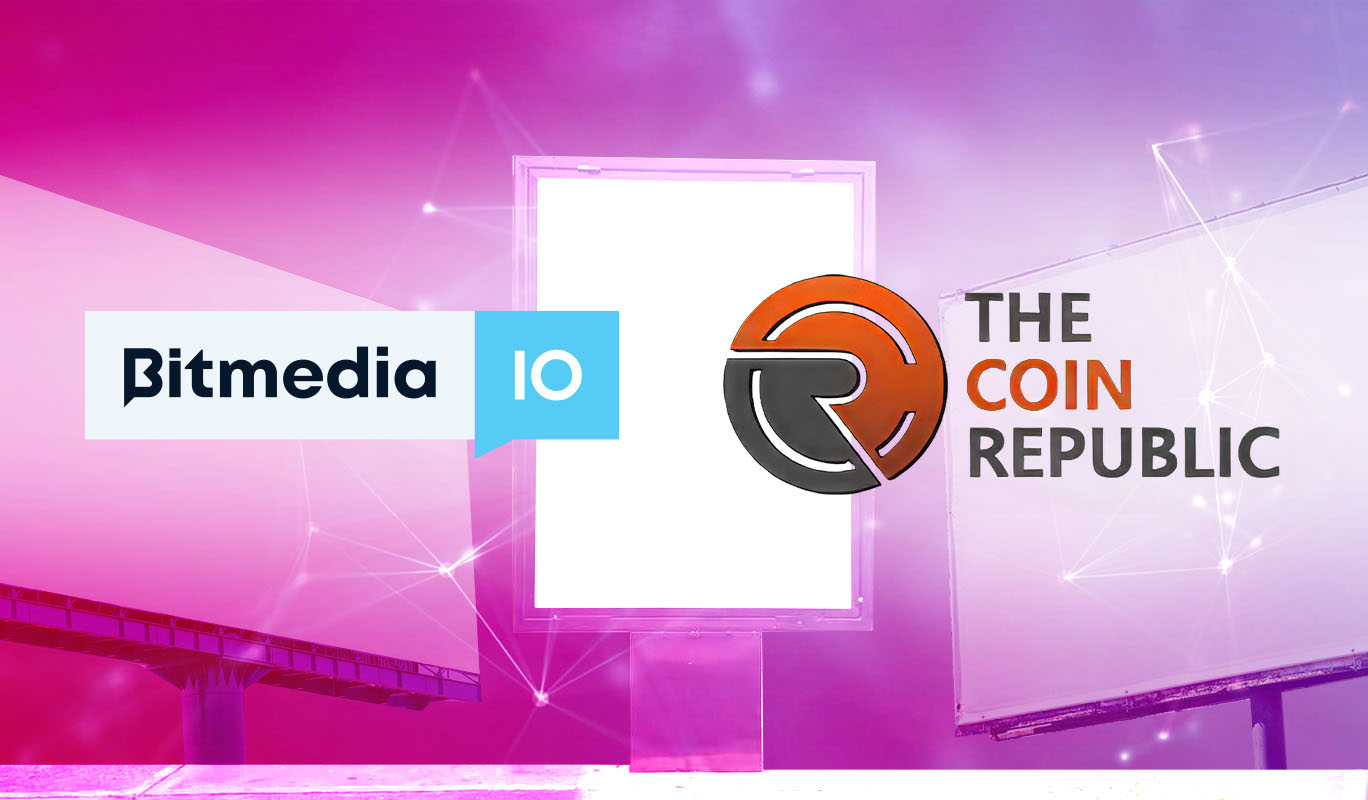How to Increase Ad Revenue as a Crypto Publisher – A Complete Guide
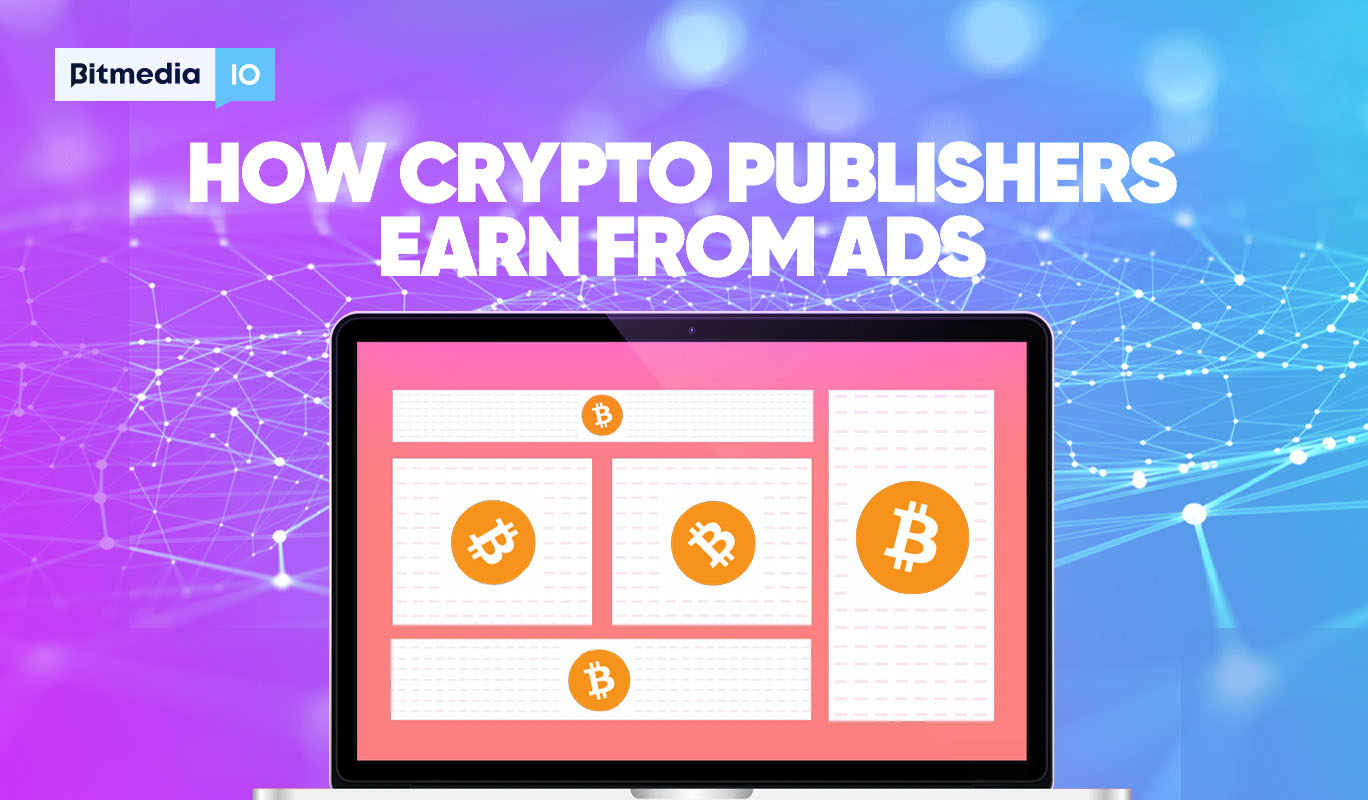
There’s a strange paradox in crypto niche. Traffic is booming, the audience is hungry for news, press releases, guides, reviews, and market insights, while many sites are still running outdated monetization setups that leave money on the table. A publisher may spend months building trust with traders or curious newcomers, only to monetize with a couple of random banner ads that pay per click pennies.
Like any business, crypto advertising is progressing, bringing new development directions to the market. There are now specialized ad networks, marketplaces, and revenue optimization strategies tailored for this niche. And the opportunity is only getting bigger. According to Amra&Elma data, global cryptocurrency advertising spending will grow to $3.5 billion in 2025, up 16.7% from 2024, with a CAGR of 30.4%.
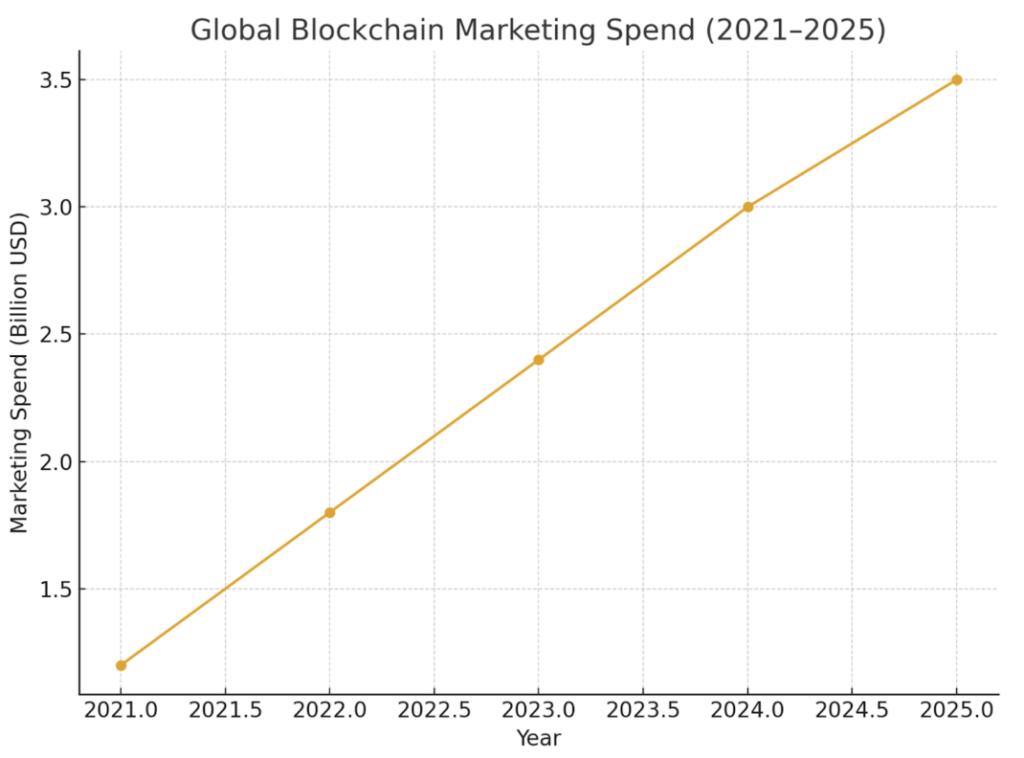
If you run a crypto blog, a Web3 content hub, or a DeFi comparison site, ad revenue can be a lifeline for smaller publishers. So, how to increase ad revenue optimisation in a way that doesn’t alienate your readers? That’s what this guide is here to cover all the aspects.
How crypto websites monetize traffic
Crypto publishers don’t need to reinvent the wheel. The building blocks are the same as in broader internet advertising, but with a small nuance. Crypto audience is more ad-savvy, more privacy-minded, and deeply tied to financial outcomes. Let’s look at the main approaches:
Working with crypto ad networks
Unlike traditional networks, a crypto ad network focuses exclusively on publishers and advertisers in the blockchain space. Crypto advertising platforms often handle compliance, offer payouts in stablecoins or crypto, and provide access to advertisers you won’t find in mainstream networks.
Best crypto ad networks compete on fill rates, CPMs, and targeting depth. You can always find ads to fill placements if you have decent traffic and a relevant audience.
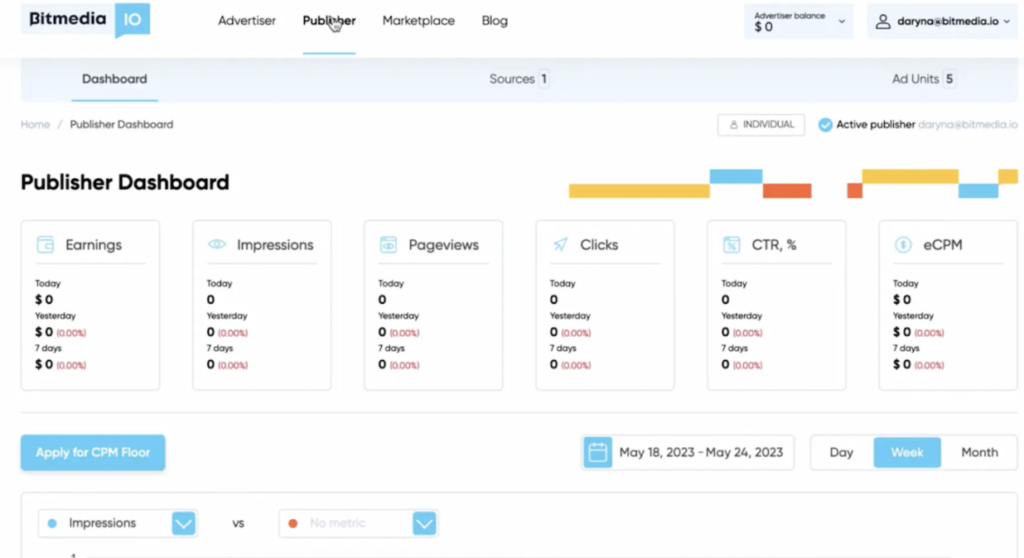
Deals directly with advertisers
Sometimes publishers cut out the middle layer and negotiate directly with crypto projects. The upside is higher margins, because you avoid sharing revenue with an advertising company. The downside is scalability, as it takes constant outreach and relationship building. Still, a well-branded publisher online can provide regular direct campaigns around token launches or new product releases.
Sponsored content and reviews
Sponsored content or reviews can generate serious ad crypto revenue. Done right, with disclosures and high editorial standards, they bring both money and value to the target audience.
Affiliate offers
Affiliate marketing is a steady stream of revenue for sites that guide users toward wallets, trading platforms, or NFT marketplaces. A publisher’s monetization strategy here relies on CPA or revenue share models. For instance, sending traders to a new exchange via your landing page can bring ongoing commissions for as long as they keep trading.
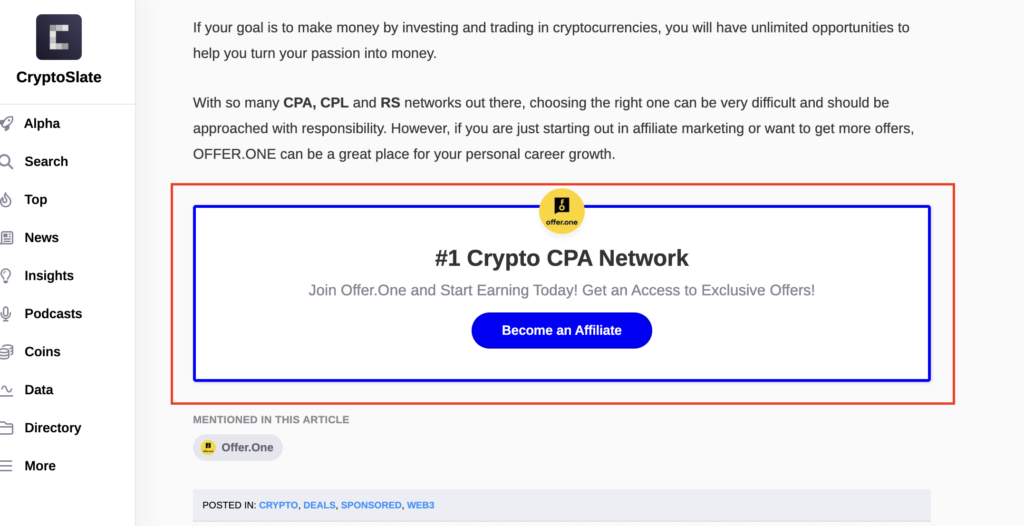
Why crypto ad monetization is different
The phrase “crypto ad” can deter traditional networks due to compliance risks. That’s why specialized crypto ad networks exist; they understand the regulatory nuance and the volatility of the market. Publishers who rely solely on Google AdSense or generic display ads may find themselves rejected for promoting DeFi guides or NFT content.
Beyond compliance, crypto audiences are different. They’re trained to spot hype and empty promises. They’ve seen enough famous ads from token projects that vanished in six months. The best advertisements for this space are the ones that blend clarity and relevance.
Another difference is payment. Traditional ad networks pay in fiat, often on net-30 or net-60 terms. A crypto ad marketplace may pay weekly or even daily, in USDT or ETH. That liquidity is a lifeline for smaller publishers who don’t want to wait months to cash out.
Best-performing ad formats for crypto audiences
The ideal formats deliver relevant offers without sabotaging credibility. Below, we’ll break down the formats that typically work best for crypto publisher monetization, with practical notes for each.
Native ads
Native ads rank high for crypto because they can match editorial context and provide actual value — product explainers, exchange comparisons, wallet walkthroughs. When a native placement is clearly labeled and genuinely informative, it can outperform banners on CTR and conversion. Native ads also reduce the “banner blindness” problem and tend to blend into newsletters and listicles well.
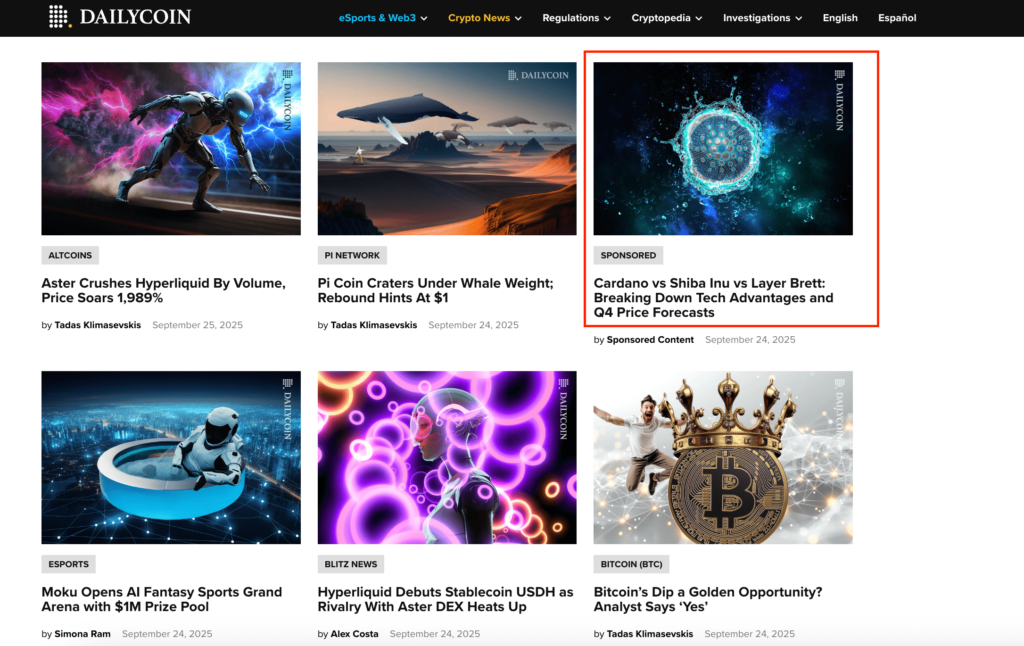
How to run them: partner with trusted crypto advertisers or use a native-capable ad network. It requires ad creatives that read like explainers. Native works great for affiliate offers and sponsored content packages.
Banner ads
Banners are still a useful basic for ads marketing. Key types such as leaderboard, MPU, and skyscraper units remain the main ones for direct deals. The right banner at the right time converts well in crypto. The only problem with banner ads is that they are easy to ignore and often blocked, so focus on viewability placements.
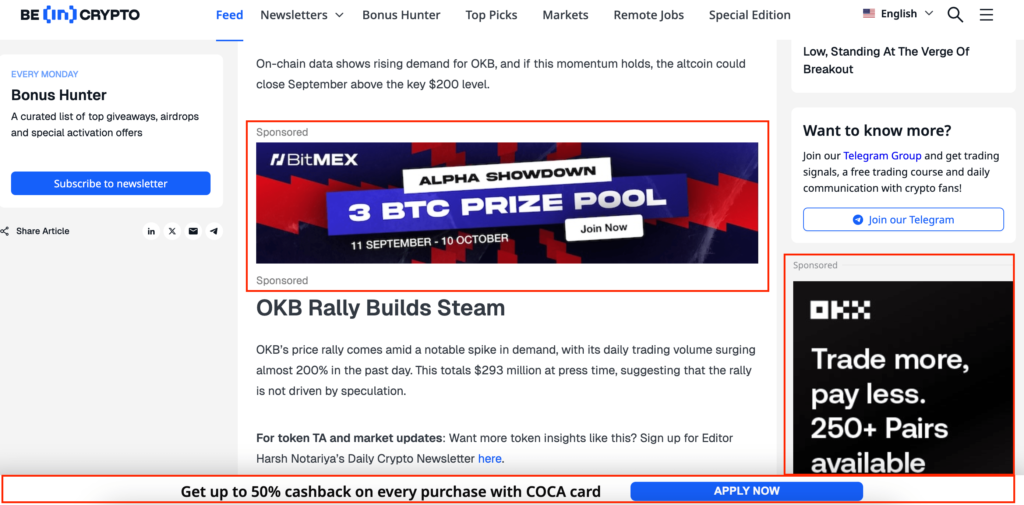
Example of a skyscraper banner ad.
Pop-Unders
Pop-unders, when used sparingly and only on low-commitment pages, can deliver high CPMs for crypto audiences. They work because they reach users after the main engagement, and conversions can come later.
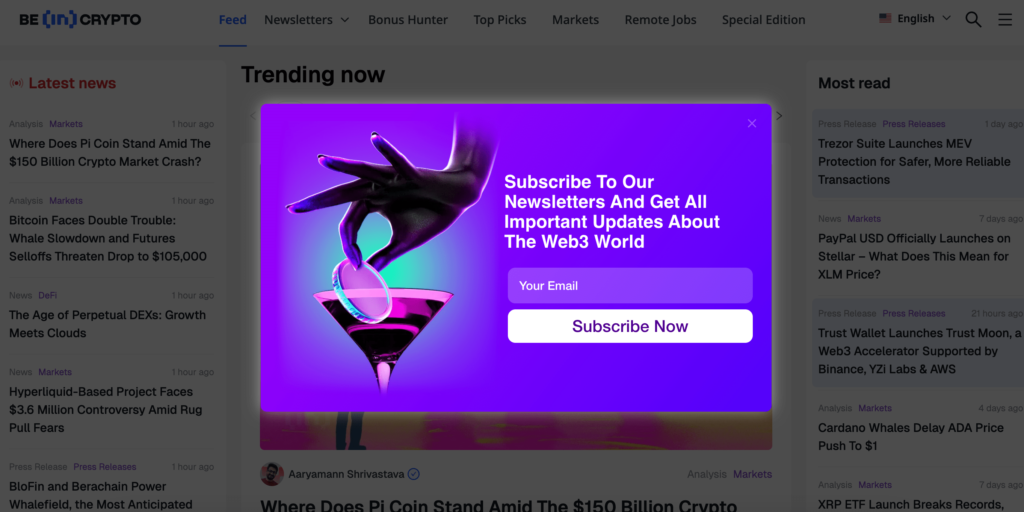
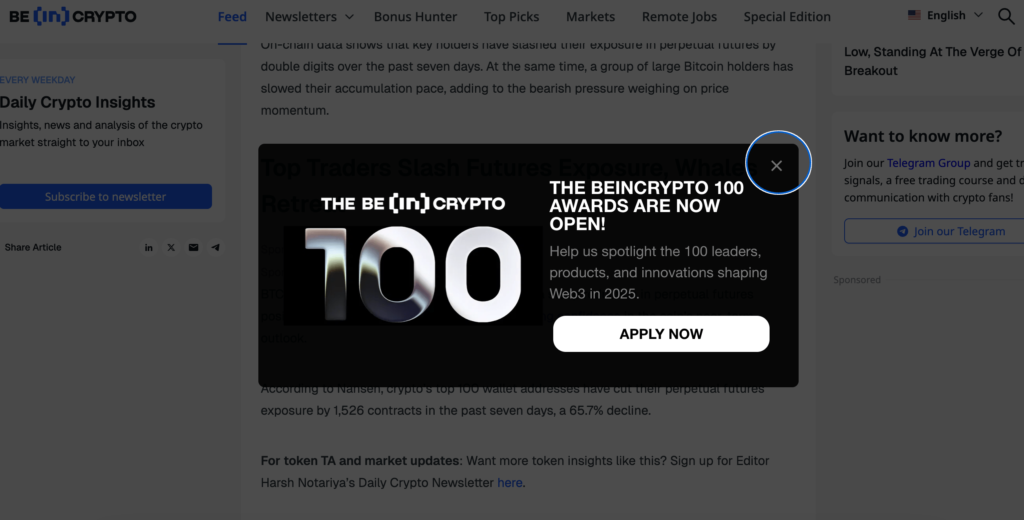
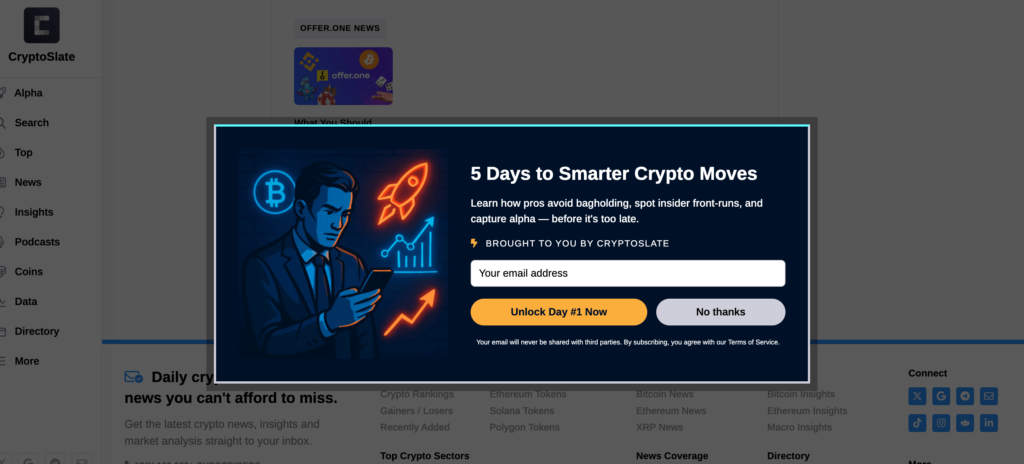
Use pop-unders for time-limited promotions or top-of-funnel ad campaigns, and limit frequency per user.
Video ads
Video ad inventory has higher eCPMs and strong branding value. Short product demos, exchange walkthroughs, and founders’ AMAs can perform well in crypto. Video is great in newsletters, only make sure autoplay is off and captions are present.
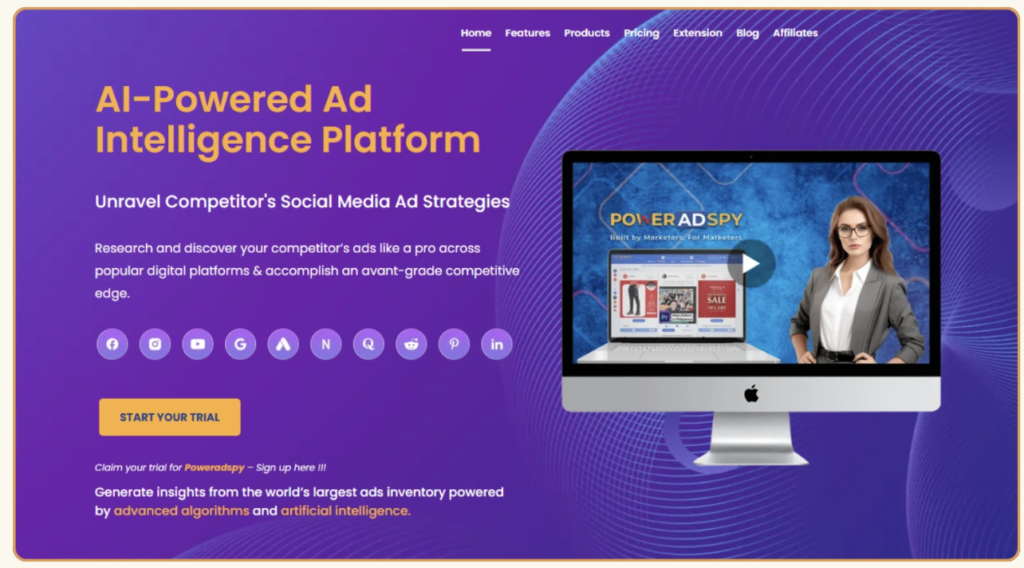
Host videos natively or use server-side ad insertion to keep load time low.
Comparative table of best-performing ad formats:
| Format | Strengths | Weaknesses | Best use case |
| Native ads | Higher CTR Blends with content Good for complex offers | Requires good creative Risk of being perceived as editorial | Long-form explainers Product comparisons Sponsored features |
| Banner ads | Wide demand Easy to scale programmatically | Banner blindness Ad blockers | High-traffic pages Direct-sold campaignsBrand buys |
| Pop-unders | High CPMs Late-stage visibility | Can annoy users Prone to ad blocking | Limited promos Time-limited offers |
| Video ads | High eCPM Strong branding | Heavy on load Requires quality creative | Product demos AMAs Show sponsorships |
How to avoid ad fatigue while maximizing revenue
You can boost short-term ad revenue optimization by stacking more creatives on the page, but that’s a trap. Here’s a playbook to keep revenue growing without burning your audience.
- Limit ad density per page and prioritize viewability over sheer impressions.
- Rotate creatives and campaigns often to avoid creative blindness.
- Use frequency capping for intrusive formats like pop-unders.
- Offer an ad-lite subscription or member tier, because some publishers monetize by selling better UX.
- Monitor ad blocker rates and show a gentle message explaining how ads support independent coverage. Experiment with messages that politely ask users to whitelist the site in exchange for ad-light experiences.
- Segment users, as heavy traders may tolerate aggressive affiliate CTAs; casual readers prefer light, informative native placements.
Case examples of crypto publishers scaling with ads
CoinMarketCal`s +156% ad revenue after switching to a managed monetization platform
Key data:
- Ad revenue increase – 156%.
- Ad ops workload reduction ~90%.
- Approach – monetization infrastructure upgrade, placement optimization, demand diversification, and fully managed sales services.
- Format – programmatic + direct campaigns + managed native formats.
“Its crypto-friendly approach, simplicity, and constant platform improvements make it a pleasure to use. The team is always responsive and supportive, which has saved us time to focus on other important tasks,” emphasized Anthony R., CEO of CoinMarketCal
This is a clear, actionable example that switching to a full-service ad monetization partner can unlock additional demand sources and sales capacity, producing very large percentage gains for niche crypto property types.
Blockworks is scaling revenue through ads, events, and subscriptions.
Key data:
- Revenue milestone – $20 million revenue goal in the referenced year.
- Blockworks raised $12M at a $135M post-money valuation.
- Approach – diversifying into research, subscription products, events, and podcast sponsorship. The company explicitly aims to scale research subscriptions.
- Cited increase from ~17 employees to ~55.
Blockworks demonstrates the “diversify beyond pure display” play. Events, research subscriptions, and podcasts can capture advertiser budgets across multiple formats and justify higher CPMs for targeted B2B/enterprise advertisers.
Actionable tips to increase crypto ad revenue
Here’s a compact playbook with specific moves. Practical advice you can test and measure:
- Audit your inventory by page type. Identify high-value pages (long reads, tutorials, reviews) and keep premium placements there. Track current CPMs and viewability.
According to Leapsome’s Workforce Trends Report, organizations using CPM report 1.25x higher productivity than their competitors, and see 1.48x better financial results than their peers.
- Implement header bidding or switch to a managed monetization platform. Header bidding or a managed solution increases demand and often eCPMs. The CoinMarketCal case study clearly shows the scale of wins.
- Create a direct sales kit and packages. Build a media kit with granular audience segments and price tiers for sponsored content.
- Introduce native placements and newsletter sponsorships. Offer themed newsletter sponsorships tied to product launches. Measure via dedicated landing pages and trackable promo codes.
“Meaningful marketing provides both clients and the press with the content that inspires, educates, and informs, to keep audiences abreast of the latest trends,” stated Erica Coates, president at Mocean. She leads teams that develop and execute tens of millions of dollars in advertising and campaign initiatives.
- Add an ad-lite or premium tier. A small recurring fee for ad-free reading can diversify revenue and improve user experience for active ones.
- Track everything with ad revenue analytics. Build a dashboard that merges site analytics and ad platform metrics, such as revenue, eCPM, fill rate, viewability, etc.
- Fight fraud and bot traffic proactively. Use verification and fraud-detection services.
Conclusion
This analysis covers some of the most well-known monetization strategies that are likely to resonate with publishers and their audiences. Native formats, video, and high-quality sponsorships outperform traditional banner ads. Case studies from CoinMarketCal and Blockworks prove that ad revenue can significantly increase with the right ad monetization platform and a balanced publisher monetization strategy.
